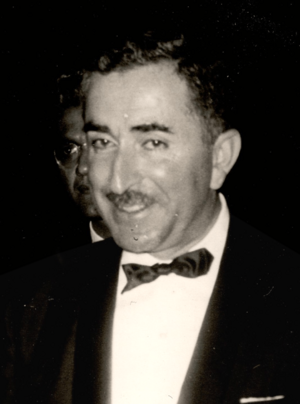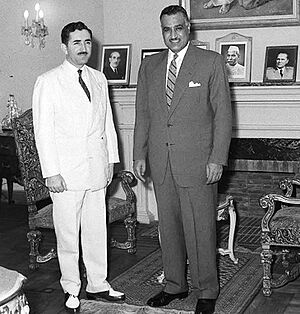Rashid Karami facts for kids
Quick facts for kids
Rashid Karami
|
|
|---|---|
|
رشيد كرامي
|
|
 |
|
| Prime Minister of Lebanon | |
| In office 30 April 1984 – 1 June 1987 |
|
| President | Amine Gemayel |
| Preceded by | Shafik Wazzan |
| Succeeded by | Selim Hoss |
| In office 1 July 1975 – 8 December 1976 |
|
| President | Elias Sarkis Suleiman Frangieh |
| Preceded by | Nureddin Rifai |
| Succeeded by | Selim Hoss |
| In office 15 January 1969 – 13 October 1970 |
|
| President | Suleiman Frangieh Charles Helou |
| Preceded by | Abdallah El-Yafi |
| Succeeded by | Saeb Salam |
| In office 7 December 1966 – 8 February 1968 |
|
| President | Charles Helou |
| Preceded by | Abdallah El-Yafi |
| Succeeded by | Abdallah El-Yafi |
| In office 25 July 1965 – 2 December 1966 |
|
| President | Charles Helou |
| Preceded by | Hussein Al Oweini |
| Succeeded by | Abdallah El-Yafi |
| In office 31 October 1961 – 20 February 1964 |
|
| President | Fuad Chehab |
| Preceded by | Saeb Salam |
| Succeeded by | Hussein Al Oweini |
| In office 24 September 1958 – 14 May 1960 |
|
| President | Fuad Chehab |
| Preceded by | Khalil al-Hibri |
| Succeeded by | Ahmed Daouk |
| In office 19 September 1955 – 20 March 1956 |
|
| President | Camille Chamoun |
| Preceded by | Sami as-Solh |
| Succeeded by | Abdallah El-Yafi |
| Personal details | |
| Born | 30 December 1921 Miriata, State of Greater Lebanon |
| Died | 1 June 1987 (aged 65) Beirut, Lebanon |
| Cause of death | Helicopter bombing |
| Political party | Independent |
| Alma mater | Cairo University |
Rashid Karami (born December 30, 1921 – died June 1, 1987) was a very important Lebanese leader. He was a key figure in Lebanese politics for over 30 years. This included a big part of the Lebanese Civil War (1975–1990). He served as Prime Minister eight times. This made him the most democratically elected prime minister in history, according to the Guinness Book of World Records 2005. He was sadly killed in 1987.
Contents
Early Life and Education
Rashid Karami was born in Tripoli, North Lebanon. His birthday was December 31, 1920. He came from a very important Sunni political family. He was the oldest son of Abdul Hamid Karami. His father helped Lebanon become independent from France. His father was also the Grand Mufti of Tripoli. This means he was the top religious judge. Abdul Hamid Karami also served as Prime Minister in 1945. Rashid Karami studied law at Cairo University. He earned his law degree in 1946.
Political Career
After finishing university, Karami worked as a lawyer in Cairo for three years. When he came back to Lebanon, he started his own law office in Tripoli. He was first chosen to join the National Assembly in 1951. This happened because his father had passed away. He kept this seat in the Assembly until he died in 1987. Just one month after being elected, he became the Minister of Justice. This was in the government led by Prime Minister Hussein Al Oweini. In 1953, he also became the Minister of Economy and Social Affairs. This was in Abdallah El-Yafi's government.
From 1955 to 1987, Karami was Prime Minister eight times. He served under every President during this period. His terms were from 1955 to 1956, 1958 to 1960, 1961 to 1964, 1965 to 1966, 1966 to 1968, 1969 to 1970, 1975 to 1976, and from 1984 until his death. Karami was only 34 years old when he first became Prime Minister in 1955. He also served as the Minister of Finance many times. He was also the Minister of Defense from 1958 to 1960, 1965, and 1975 to 1976. He was also the Minister of Foreign Affairs several times.
He often had disagreements with Lebanon's Presidents. However, they still chose him because of his strong political connections. He was known as a "man for all crises." This was because Presidents often asked him to lead during difficult times. He was good at leading the opposition without completely breaking ties with the President.
His Character and Style
Rashid Karami was a very popular political figure. He did not have his own army, unlike some other leaders. He spoke in a grand style, common for Arab politicians. But he was also very skilled at the tricky world of Lebanese politics. He always tried to stay as the head of the government. He would only step down if he felt it was impossible to continue. This was often due to the chaos and violence in Lebanese politics.
He spoke French very well and understood English. But he always used an interpreter when talking to foreign reporters. He insisted on speaking Arabic. People described him as a gentleman with polite manners. He was soft-spoken and had good taste in clothes. The Lebanese newspapers often called him al effendi, which means the gentleman.
Key Policies and Views

Karami strongly believed in giving more political power to Lebanon's Muslim community. During his time, the Muslim population grew larger than the Christian population. This was a big change for the country. He tried to get more seats for Muslims in the National Assembly. At that time, Muslims had 45 percent of the seats. This number was not changed even as the population changed. In 1976, Karami helped create an agreement. It would give equal seats to Christians and Muslims in parliament. But this agreement was never put into action. One change that Christian politicians did allow was that the Prime Minister had to sign laws too. This started in 1974. This gave the Prime Minister (who was always a Sunni Muslim) a way to stop laws.
Karami was part of the Muslim-Leftist group in Lebanese politics. In the 1950s, he supported Pan-Arabism. This was a movement led by Egyptian president Gamal Abdel Nasser. Karami first became Prime Minister under President Camille Chamoun in September 1955. But by the next year, he disagreed strongly with Chamoun. Chamoun refused to cut ties with Western countries that had attacked Egypt. This happened during the 1956 Suez Crisis in 1956. Karami again opposed Chamoun in the 1958 Lebanon Crisis. This was an uprising that wanted to join Egypt and Syria. It had a lot of support from the Muslim community. By September, Chamoun stopped the uprising with help from the United States. Karami then formed a government that included different groups. This was under the new president, Fuad Chehab.
The Arab–Israeli Conflict
Karami served as prime minister four more times in the 1960s. During this time, he supported the Palestinian cause. He believed Lebanon should do more against Israel in the Six-Day War of June 1967. Many Christians did not agree with this idea. There were more and more clashes between the Lebanese army and the Palestine Liberation Organization (PLO). This led to his resignation in April 1970. But he returned to office in 1975 after an agreement between Lebanon and the PLO. In August of that year, Suleiman Frangieh became president. Frangieh was an opponent of Karami. Karami resigned, and Saeb Salam took his place.
Lebanese Civil War
The Lebanese Civil War started in April 1975. Many different groups were involved. The political and military situation was very complicated. Generally, the war was fought between Christian groups and Muslim groups. The Muslim groups were allied with Palestinians. President Frangieh wanted to make things stable. He removed Prime Minister Rashid al-Solh and asked Karami to form a government. This happened on July 1. Karami changed his strong support for the Palestinians a bit. He supported Syrian military help in June 1976. Even with Karami's experience, he could not end the war. He resigned on December 8, 1976. Elias Sarkis became president and appointed Selim Hoss as the new Prime Minister.
Karami had his own local armed group in Tripoli. He made peace with his old opponent, Suleiman Frangieh, in the late 1970s. This happened after Frangieh had a falling out with another leader. Karami, Frangieh, and Walid Jumblatt created the National Salvation Front in July 1983. This group supported Syria. It included Sunni Muslims, Druze, and some Christians. They were mostly in northern Lebanon. The National Salvation Front was against President Amine Gemayel. They also opposed an agreement between Lebanon and Israel.
In April 1984, Karami became Prime Minister for the eighth time. He led a government that tried to bring different groups together. During this time, Syria gained more influence. This was after Israel partly pulled out of Lebanon. Israel had invaded Lebanon in 1982, which Karami strongly opposed. In 1986, he rejected a plan to solve the Lebanese crisis. This plan was made with very little input from Sunni Muslims. This disagreement caused tension with President Amine Gemayel. Problems continued, and Karami resigned on May 4, 1987. But Gemayel did not accept his resignation. He saw no one else who could lead.
Personal Life and Death
Rashid Karami never married.

On June 1, 1987, Karami was killed. A bomb was placed in his helicopter. He was flying from Tripoli to Beirut. The bomb weighed about 300 grams. It was controlled by a remote from up to 10 kilometers away. The bomb was attached to the back of his seat. It exploded soon after the helicopter took off from an army airfield. Karami was the only person who died in the explosion. The Interior Minister and at least three other people on board were hurt. A Maronite leader named Samir Geagea was accused of this killing in 1994.
Burial
Rashid Karami was buried in a cemetery in the Bab al Raml area of Tripoli. People offered their condolences at the International Fair of Tripoli. This building was designed by Oscar Niemeyer.
Investigation and Accusations
After the killing, a man claimed responsibility for it. He called a news agency in Beirut. He said he was from a group called the Lebanese Secret Army. In 1999, Samir Geagea and ten other members of the Lebanese Forces were found guilty of the assassination. After Syria left Lebanon in 2005, Samir Geagea and the others were pardoned. They were released from jail. Some people, like Ashraf Rifi, have suggested that a Syrian officer led Karami to the helicopter on purpose to kill him.
See also
- List of assassinated Lebanese politicians

